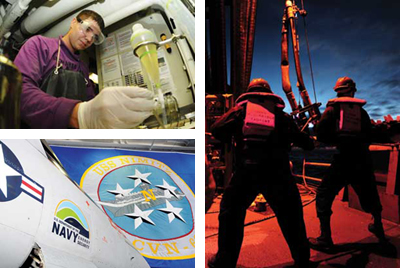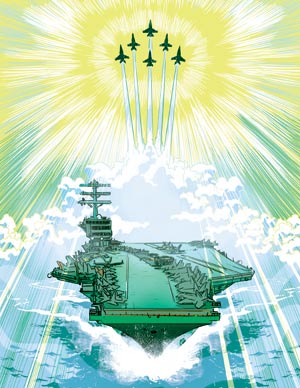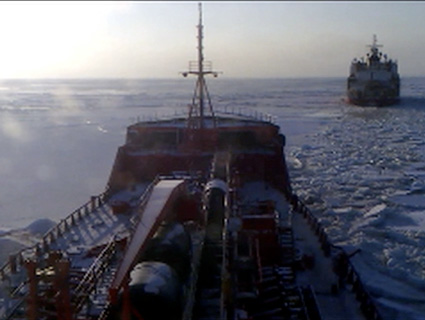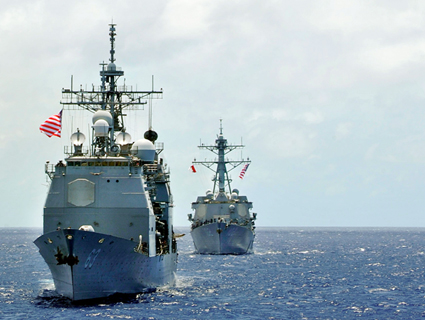I’m strapped into my backward-facing seat on a COD, or “carrier onboard delivery” plane, the US Navy workhorse that ferries people, supplies, and mail to and from its aircraft carriers at sea. I cinch the four-point harness holding me in place. Then I cinch it some more. When it’s as tight as it can go, an aircrewman walks by and yanks it so hard it squeezes the breath out of me. The hatch closes. Steam rises from the floor. Shit. I’ve watched the YouTube videos. I know what’s coming. Takeoff, a 30-minute flight, then landing on the USS Nimitz, decks pitching, plane wings waggling, tailhook dangling from the underside of the aircraft to catch one of four arresting cables stretched across the flight deck. Since it’s not hard to miss them all, the pilot will gun the engines at landing to enable an immediate relaunch. Which means that if he succeeds at trapping a cable we’ll decelerate from 180 nautical miles per hour to zero in about one second.
To get to the Nimitz, 100 miles off Honolulu, our turboprop is flying a 50-50 blend of biofuel and standard JP-5 shipboard aviation fuel. The biofuel is made from algae plus waste cooking oil. This makes us part of history, my aircrewman says, players in what the Navy calls the Great Green Fleet demonstration of July 2012. It’s paired with a three-year, $510 million energy reform effort in conjunction with the departments of Agriculture and Energy as part of a larger push to change the way the US military sails, flies, marches, and thinks. “As a nation and as a Navy and Marine Corps, we simply rely too much on a finite and depleting stock of fossil fuels that will most likely continue to rise in cost over the next decades,” announced Navy Secretary Ray Mabus at the launch of the program back in 2009. “This creates an obvious vulnerability to our energy security and to our national security and to our future on this planet.”
The Navy has set five ambitious goals to reduce energy consumption, decrease reliance on foreign oil, and significantly increase the use of alternative energy. Part of one target is to demonstrate a Great Green Fleet by 2012, and that’s what’s sailing this July day in Hawaii’s cobalt-blue waters: a carrier strike group comprising an aircraft carrier, two guided-missile destroyers, a guided-missile cruiser, and an oiler. All are running at least partially on alternatives to fossil fuels: the Nimitz on nuclear power, the other ships on that biofuel-diesel blend. The 71 aircraft aboard—Super Hornets, Hornets, Prowlers, Growlers, Hawkeyes, Greyhounds, Knighthawks, and Seahawks—are burning the same cocktail as my COD. All of today’s biofuels are drop-in replacements for marine diesel or aviation fuel and are designed to run without any changes to the existing hardware of ships or planes. “No [nation] can afford to reengineer their navies to accept a different kind of fuel,” Vice Adm. Philip Cullom, deputy chief of naval operations for fleet readiness and logistics, tells me.
The Great Green Fleet is debuting at the 2012 RIMPAC (Rim of the Pacific) exercise, the largest ever international maritime war games, engaging 40 surface ships, six submarines, more than 200 aircraft, and 25,000 personnel from 22 nations. For the first time Russian ships are playing alongside US ships, and naval personnel from India are attending. Many fleets here are sharpening their focus on alternative fuels and working to assure the formulations are codeveloped with their allies. “We’ve had dialogue with the Australians, the French, the British, other European nations, and many others in the Pacific,” and they all want to take “the petroleum off-ramp,” Cullom tells me. “We don’t want to run out of fuel.”
You can’t live off the land at sea, which is why the Navy has always looked far into the future to fuel its supply lines; the job description of admirals requires them to assess risk and solve intractable problems that stymie the rest of us. Peak oil, foreign oil, greenhouse emissions, climate change? Just another bunch of enemies. So when the Department of Defense set a goal to meet 25 percent of its energy needs with renewables by 2025, the Navy found itself fighting on familiar ground. Four times in history it has overhauled old transportation paradigms—from sail to coal to gasoline to diesel to nuclear—carrying commercial shipping with it in the process. “We are a better Navy and a better Marine Corps for innovation,” Mabus says. “We have led the world in the adoption of new energy strategies in the past. This is our legacy.”
It goes beyond supply lines. Rising sea levels lapping at naval bases? A melting and increasingly militarized Arctic? The Navy is tackling problems that freeze Congress solid. What it learns, what it implements, and how it adapts and innovates will drive market changes that could alter the course of the world.

But not without a fight. Six weeks before RIMPAC 2012, Republicans and some coal- and gas-state Democrats tried to scuttle Mabus’ Green Fleet by barring the Pentagon from buying alternative fuels that cost more per gallon than petroleum-based fuels—the biofuel blend cost more than $15 a gallon—unless the more expensive alternative fuels come from other fossil fuels, like liquefied coal. This tricky logic made sense to Sen. James Inhofe (R-Okla.)—”[The Pentagon] should not be wasting time perpetrating President Obama’s global warming fantasies or his ongoing war on affordable energy”—even though seven years earlier Inhofe helped secure a $10 million taxpayer fund to test renewable military fuels, more than half of which went to a company in his home state. Sen. John McCain (R-Ariz.) agreed, calling the purchase of biofuels “a terrible misplacement of priorities” and adding, “I don’t believe it’s the job of the Navy to be involved in building…new technologies.” Mabus, who’d already bought the biofuels for the RIMPAC demo, fired back: “If we didn’t pay a little bit more for new technologies, the Navy would never have bought a nuclear submarine, which still costs four to five times more than a conventional submarine.”
En route to the Nimitz I’ve managed to snag a seat next to one of only two windows in the COD’s dark cabin. Through the porthole I watch our transect over Pearl Harbor, the USS Arizona Memorial, and the sunken and rusting remains of much of the 1941 Pacific fleet. Beyond Pearl we climb over the Pacific Ocean, at 60.1 million square miles nearly half of Earth’s total ocean area. That’s a lot of territory over which to maintain maritime supremacy, while guarding the far-flung energy supplies needed to do it. Some 75 percent of the world’s fuel travels by sea, with 20 percent passing through vulnerable choke points like the Strait of Hormuz and the Gulf of Aden, many guarded by US forces. Partly in defense of those lines, the Department of Defense burns more than 12 million gallons of oil a day. About a third of the DOD’s fix goes to float the Navy, the world’s largest, with a battle fleet tonnage exceeding the next 13 biggest navies combined.
Out over the ocean my turboprop hums merrily along on its biofuel blend, and so do I, until I catch my first glimpse of the Nimitz out the window—a toy miniature in a turbulent bathtub. Suddenly 1,092 feet of flight deck wedged into a ninth the space allotted a commercial landing strip seems insanely small acreage. “Go, go, go!” shout two aircrewmen, their backs to me, waving their hands in the air. This is the signal to prepare for the controlled crash of a carrier landing. We jam our heads into backrests, cross arms over our chests, hook hands into harnesses, and wait. It’s an unnerving interlude, all noise dampened by the cranial I’m wearing, a helmet with built-in headphones clamped so tight my jawbone aches. Goggles down, I await what I can’t see. A minute drags by. Ferociously. Another. Inflatable rafts twitch in overhead cargo nets. Then the sounds of a mass pileup on a steel interstate. Legs whiplash in the air. An unidentified flying object clips my head. It feels exactly like a tragedy at 180 nautical miles an hour—only nothing breaks, burns, or drowns at the end of it. And now here I am, on an aircraft carrier cruising at 30 knots of speed, safe and sound.
It’s the Navy, so there’s history. The Great Green Fleet was named after the Great White Fleet launched by President Theodore Roosevelt in 1907: four squadrons of 16 battleships painted bright white and manned by 14,000 sailors and Marines on a 43,000-mile cruise around the world. It was the first ever armada of coal-powered steam battleships built entirely of steel—the product of years of government subsidies paying three times the market rate to develop a fledgling American steel industry. When Congress moved to blockade the fleet’s around-the-world funding, Roosevelt snarled at them to “try and get it back.” So the fleet sailed to 20 ports on six continents over 14 months, boldly going where no US military had gone before and announcing the debut of the United States as a player on the World Ocean.

Even then the fight over a newfangled Navy was old. For a time in the 19th century it proved so psychologically difficult to get away from sail that hybrid naval ships sported steam funnels alongside acres of snowy white canvas. Naysayers swore the Navy was giving up reliable propulsion for dangerous and infernal machines. The great 19th-century naval strategist Alfred Thayer Mahan wrote: “Sails were very expensive articles…but they were less costly than coal. Steam therefore was accepted at the first only as an accessory, for emergencies.” Acting on the principles Mahan laid out in The Influence of Sea Power Upon History—a seminal book in naval strategy—the United States methodically and expensively procured ports and territories around the world specifically for use as Navy coaling stations: Guam, Guantanamo Bay, Hawaii, Puerto Rico. Yet by the time the Great White Fleet sailed home again in 1909, the coal era was over and the Navy was converting yet again, this time to oil-burning steamships. It took a lot of oil to drive a steamship, and the realization that oil wasn’t going to last forever dawned far earlier in the military than among civilians. To keep the Navy afloat as long as possible, Congress passed the Pickett Act of 1910, commandeering lands in California and Wyoming, and later in Alaska, as Naval Petroleum Reserves, some of which ultimately ranked among the highest-producing oil and gas fields in the country.
The same year the Great White Fleet sailed home, 24-year-old Ensign Chester Nimitz, the man destined to be the namesake of the nuclear-powered USS Nimitz, took command of an early submarine, the USS Plunger. It was a crap assignment; young officers wanted battleships, the sexy beasts of the Navy. But Nimitz was in disgrace for having run a ship aground in the Philippines. Derisively, he called his sub “a cross between a Jules Verne fantasy and a humpbacked whale.” Yet he took the job seriously and began to lobby for an undersea fleet that ran more safely and efficiently on upstart diesel engines, in contrast to the gasoline-powered Plunger. By 1911 he had successfully skippered another energy transformation, overseeing the development of the first diesel submarine, the USS Skipjack, followed by the first diesel surface ship, the USS Maumee (an engineering task that cost him a finger). Thirty-five years later, as chief of naval operations, Nimitz changed the fleet’s course once again when he championed Capt. Hyman Rickover’s fiercely contested bid (Rickover’s opponents reportedly exiled him to an office in an abandoned women’s bathroom) to establish a nuclear-powered Navy.
“Every single time there were naysayers,” Secretary Mabus has said. “And every single time those naysayers have been wrong.”
Mabus has touched down aboard the Nimitz for the Great Green Fleet demo in a biofueled Seahawk helicopter. Wearing his flight helmet rakishly askew, looking more the politician than the former sailor, he’s piped aboard with a time-honored bosun’s whistle before passing through a hatch freshly stenciled with the Navy Energy Security logo, a blue and green wave. Maneuvers get under way on the flight deck where F-18s—today called “Green Hornets,” with their nose cones striped green—are taking off at 60-second intervals. The entire ship, all 97,000 tons of it, shudders from the muscle of 67,000-pound warbirds shot into the air from steam catapults. Water for the catapults comes from the Nimitz‘s four distilling units, which make 400,000 gallons of freshwater daily, mostly to cool the twin nuclear power plants that allow the Nimitz to sail the seas for 25 years between uranium fill-ups. In the skies above, in perfect formation flybys, jet fighters buddy-fuel each other through a hose-and-drogue system. Off our bow, while all three ships steam at 13 knots, the oiler USS Henry J. Kaiser refuels the cruiser USS Princeton, off-loading the last of today’s 900,000 gallons of 50-50 biofuel blend—the largest ever purchase of alternative fuel by the US government.
“We’re seeing the Navy once again leading in the type of fuel we use and how we procure it,” Mabus tells an all-hands assembly in the vast interior space of a hangar bay on the Nimitz. “Today shows we can reduce our dependency on foreign oil.” The crew is jammed shoulder to shoulder: sailors in marine camouflage or “blueberries,” Marines in woodland camouflage, aircrew in jumpsuits, deck crew in bold-colored turtlenecks that signal at a glance their jobs on the floating war port. It’s so orderly and polite, what I imagine a small-town political rally of the 1950s to be, complete with stage bunting, an American flag the size of Kansas, and testy microphones. Except there’s a giant ocean heaving by outside the bay door, advanced electronic aircraft parked in the wings, a cluster of admirals wearing Green Fleet caps on the stage (of the hats, McCain griped a week later: “I do not believe this is a prudent use of defense funds”), plus a handful of reporters, a few looking seasick. Today’s demo is a milestone in Mabus’ energy plan. But it’s also a day for the sailors, one pilot tells me, since the media presence here will raise awareness among the rank and file better than anything the Navy itself says about the seriousness of its green purpose.
“You have the senior Navy leadership here today,” crows Mabus, as the chief of naval operations, Adm. Jonathan Greenert, takes the stage to praise the crew of the cruiser USS Chafee. “What I saw today was theory of practice,” Greenert says. “We didn’t have some scientist come down into the engine room and say, ‘One day you’ll see this.’ You hear it today and see it on gauges.” He’s talking about the technologies developed to further stretch whatever fuel the Navy procures: low-tech add-ons like stern flaps to reduce ships’ drag and increase fuel efficiency; high-tech plug-ins like energy dashboards with Prius-type feedback on fuel consumption; energy savers like LED lighting; plus your basic turn-off-the-lights mindset. “If we deploy these energy efficiencies fleetwide,” Mabus says, “we can save up to a million barrels of oil a year. And with what we’re paying, about $150 a barrel, that’s $150 million the Navy can save a year.”
Those aren’t the Navy’s only goals. Wide-reaching targets include: awarding Navy and Marine Corps equipment contracts based on better fuel efficiency; deploying (not just demonstrating) a Great Green Fleet carrier strike group by 2016; phasing in hybrid fuel and electric vehicles to halve petroleum use in the Navy’s 50,000 commercial vehicle fleet by 2015; requiring that by 2020 each base—the Navy owns 2.2 million acres of land plus 65,000 buildings—be at least 50 percent self-powered by renewables like solar, wind, and wave energy; and ensuring that at least 50 percent of the Navy’s total energy consumption comes from alternative sources by 2020. These changes will ripple out to the civilian world, too—just as military demand propelled the development that eventually drove down the cost of American steel, radar, GPS, and microchips.
But there are naysayers. In an op-ed in US News, Thomas Pyle, president of the Institute for Energy Research—a nonprofit tied to Koch Industries—calls the Navy’s biofuel goals “ridiculous” and an “inexcusable example of government cronyism.” And Noah Shachtman, editor of Wired‘s influential national-security blog, Danger Room, blasted Mabus for not shoring up political or statistical support before going full steam ahead on his biofuel mission. That said, the $12 million spent so far on biofuels is four one-hundredths of 1 percent of the Navy’s annual fuel consumption, what the department would pay for an increase of less than a cent per gallon of oil, according to Mabus. In fact the entire biofuels budget currently totals less than a hundredth of 1 percent of the Pentagon’s nearly $650 billion annual budget.

Remarkably, there’s very little opposition inside the Navy. “Some of the oldest, most experienced officers, if you’d asked them 10 years ago, they’d say we should never change our energy ways,” Capt. James Goudreau, director of the Navy Energy Coordination Office, tells me. “But now they’re in the position that they actually have to run the fleet, have to manage and pay for its operations. They see that we can’t afford to do what we used to do.”
Plus petroleum isn’t the bargain it seems. Factor in the price of guarding and moving it from the Middle East. Factor in the battlefield cost of transporting a gallon of fuel across oceans to a coastal facility in Pakistan, or airlifting it to Kandahar, then loading it onto a truck, guarding that truck, and delivering it to a battlefield. In extreme cases, that single gallon of gasoline can cost the DOD up to $400. “That’s too high a price to pay for fuel,” says Mabus, a former governor of Mississippi who became a renewables convert while serving as US ambassador to Saudi Arabia in the Clinton administration. “In the drive for energy reform, and this is critical, the goal has got to be increased warfighting capability. Too many of our platforms and too many of our systems are gas hogs.”
The lethal costs of petroleum are even higher. For every 24 fuel convoys the United States transported in Afghanistan in 2007, a soldier or civilian contractor was killed or wounded. And extreme volatility can make it difficult to judge what the worst-case scenario could be. “Every time the cost of a barrel of oil goes up a dollar, it costs the United States Navy $31 million in extra fuel costs,” Mabus says. When oil spiked in 2008, the Navy suddenly had to forecast “our fuel bill rising from roughly $1.2 to $5.1 billion” over a few years, says Vice Adm. Cullom. “When your fuel bill goes up that much, you’ve got to ask yourself, ‘What are you not going to do?’ You’re either going to buy fewer ships, fewer planes and tactical vehicles, or you’re going to buy less fuel and not send your ships out.”
“The cheapest barrel of fuel is the one we never burn,” Goudreau tells me. “Eighty-five percent of what we do each year is chasing efficiency.” To foster this kind of thinking, the Navy is grooming a new generation of “energy warriors” at its Naval Postgraduate School in Monterey, California. Fuel-saving incentives are factored into promotions servicewide. In 2011, these efforts saved 11 percent of fuel costs, awarding the Navy an additional 56,500 hours of “free” steaming time at sea. The initiative was so successful that a similar program has been launched to optimize fuel consumption aboard the Navy’s 3,700 aircraft. Meanwhile, in Afghanistan, Marines using solar panels have reduced their need for fuel and battery deliveries at forward operating bases by up to 90 percent.
As for the thorny problem of scaling up to operational biofuel, the Navy is investing $170 million in American biofuel companies, an amount matched by the departments of Agriculture and Energy. And not just any (or only) biofuels. “The Navy is mindful of not trading one fuel problem for another,” Goudreau says. “Our alternative fuels can’t compete with food crops. We don’t want to alter the price of food and then cause regional instability that we have to respond to. That would be shortsighted. We can’t drive up big irrigation requirements. Plus our fuels have to meet congressional language requiring a carbon footprint the same or smaller than petroleum.” This reflects the way the Navy bills itself in an era where “It’s not just a job, it’s an adventure” has been superseded by “A global force for good,” a philanthropic-sounding slogan thought to appeal to recruits less excited by pure martialism. Goudreau describes how US ships were forced to turn away from relief work off Japan after the 2011 earthquake. “Because our ships consume energy at the rate they do, we had to steam over the horizon to refuel, and then come back,” he says. “The ability to operate more efficiently means we could stay on station an extra day or three when it absolutely counts the most.”
Goudreau echoes what all the Navy people tell me: Where the Navy leads, others will follow. That’s no small matter when you consider that in 2008 more than 90 percent of global trade traveled by ocean aboard 90,000-plus cargo ships burning the foulest of fuels, making shipping the sixth-biggest CO2 emitter after China, the United States, Russia, India, and Japan. Goudreau is confident that once the Navy tests and finds the best fuels, commercial fleets—both shipping and aviation—will drive the price to competitiveness and, in a virtuous cycle, further relieve the pressure on the Navy to protect oil supplies. “If we do this right,” he says, “we’ll turn vulnerability into capability.”
“We’re definitely motivated,” says Robert Sturtz, formerly of United Airlines, one of several industry executives on the Nimitz today to see firsthand how fighter jets and other naval aircraft fare with the Navy’s biofuel in their tanks. “We’re already facing carbon emissions taxes in European airports,” he says. “We have to find ways to bring those costs down.”
The Navy pilots aboard the Nimitz are cool with biofuels. “I’m happy to be part of history,” says Lieutenant Adam Niekras, an MH-60R Seahawk helicopter pilot. “And I saw no difference in performance at all.” Lt. Commander Jason Fox, pilot of an E-2C Hawkeye, a radar early warning plane, reflects: “The military has done a lot of things that started a tidal wave in our culture. Plus, I’d really rather not fight to defend fossil fuels if there are alternatives.” Fox flies with the VAW-117 “Wallbangers” squadron. In their ready room, which boasts a banner that reads “Bangers Lead the Way,” they’re peddling squadron T-shirts to press and dignitaries that read: “Keeping the Earth Green, One Bag of Biofuel at a Time.”
Sure, the Great Green Fleet demonstration is a public-relations gesture. But it seems to be spin in defense of a genuine sea change. Last May, the House and Senate armed services committees voted to kill biofuels, but after the RIMPAC demo, Congress reversed that decision. Congress also voted to remove obstacles preventing the Navy’s plan to invest $170 million in companies building advanced biofuels refineries—an amount matched by both the Agriculture and Energy departments. Along with more than $53 billion in future public-private investments, this plan opens the door for at least 13 billion gallons of advanced biorefinery production capacity to come online in the next decade, according to clean-tech analysts Pike Research. These will be among America’s first commercial-scale biorefineries, forecast to create up to 17,000 new jobs. Which may well mark the tipping point Capt. Goudreau suggested, the moment when the reassurance from long-term military contracts begins to propel a competitive and self-perpetuating market. Already, since the Navy starting buying biofuels in 2009, the price per gallon has dropped by more than half. “The Navy’s leadership has already sped up the commercialization of advanced biofuels by at least a decade and set this important option on a path to commercial viability at scale,” says Amory Lovins, chair and chief scientist at the Rocky Mountain Institute, who helped prod the Navy toward clean energy. “It has primed the pump for great flows of scaling and innovation.” Mabus is optimistic: “I believe that if the Navy can fully pursue its initiatives, [biofuels] will reach cost-competitiveness in 2016—four years ahead of the 2020 target date.”
When recently asked by Esquire about his most important legacy as defense secretary, Leon Panetta cited the energy paradigm, especially in the Navy: “Our ability to develop alternative energy and energy independence not only saves money, but it’s an investment in our national security.”
I’VE TAKEN ONE BITE of my lunch in the officer’s wardroom when Capt. Kevin Mannix, commander of the carrier air wing, runs up and tags me on the shoulder. “Wanna see the Australian helicopter land?” I do. But what about lunch? He shrugs and jogs for the door. Everything in the Navy moves fast. Already I’ve hiked miles at a punishing pace up and down countless ladders connecting decks to get from one end of the ship to the other while circumventing the things the Navy doesn’t want me to see. The Nimitz crew is frustrated by the Royal Australian Navy (RAN), which is running an hour and a half behind schedule for the meeting. Tardiness, I gather, is keelhauled out of sluggish US sailors, and my escorts struggle to hide the WTF looks on their faces. Australians, on the other hand, have pubs on their navy ships. Since I’m half Australian, I find myself enjoying the clash of cultures.
Mannix drives me up 12 levels at breakneck speed, shoves a cranial and two “foamies” (earplugs) at me, and tells me to protect myself. Then he ushers me out to Vultures Row, the viewing deck six levels above the flight deck, to watch a Seahawk helicopter from the Australian frigate HMAS Perth set down: a battleship-gray butterfly alighting on the Nimitz‘s stern. As its passengers unfold from the interior, Nimitz deck crew wearing the purple jerseys of fuelers run out a hose to top it off with biofuel nectar—the first RAN aircraft ever to feed on the stuff.
The Aussie fleet commander, Rear Adm. Tim Barrett, is piped aboard and ushered below to the stage of a hangar bay reconfigured for the day’s historic signing. Behind a small table that looks like it might double for a poker game later that night, he delivers to Secretary Mabus a statement of understanding that the navies will cooperate on stabilizing biofuel prices and supplies toward the common goals of a permanent Green Fleet deployment in 2016 and on helping the US Navy attain its goal of having its nonnuclear fleet powered by a 50-50 biofuel blend by 2020. The Aussies are here because Australian government-funded research has shown that algal biodiesel is cheaper than fossil diesel in terms of both money and carbon, and because government-funded companies are already scaling up toward large algae-growing operations in open saline ponds. “Western Australia has some great places and an ideal climate to grow and develop algae in saltwater,” US Navy Vice Adm. Cullom tells me. Better than anywhere in the United States. Add algae to other advanced biofuels and you might just get enough to meet the Navy’s 2020 goal of 8 million barrels per year. “We are here to learn what we need to do to remain interoperable with the US,” Barrett told the Australian. “We’d be mad not to be involved.”
Practically speaking, the Aussies are also here because of a fundamental geopolitical shift under way in the United States. “After a decade in which we fought two wars that cost us dearly in blood and treasure,” President Obama told the Australian Parliament in 2011, “the United States is turning our attention to the vast potential of the Asia Pacific region.” That includes deploying 2,500 Marines to Australia’s Northern Territory and sending more warplanes, ships, and submarines through Down Under ports. China is the concern, along with the South China Sea, a body of water that lies closer to Australia than Chicago is to San Francisco and is believed to sit atop vast oil and gas reserves. China calls it the second Persian Gulf and now claims much of its waters as its own—to the alarm of the Philippines, Vietnam, Malaysia, Taiwan, and Brunei. The scramble over who can drill a hole where in that seafloor is already escalating into battles between Chinese and Filipino fishing boats while drawing warning shouts from faraway Russia, India, and the United States.
The Navy worries that a growing Asian demand for oil will inevitably drive prices higher. A newly seagoing China—Beijing just landed its first jet on its new aircraft carrier—along with the expected gas rush in the South China Sea, have reportedly focused the roving US military eye on a few unlikely morsels of sand barely rising above the waves off Australia’s northwestern coast: the Cocos (Keeling) Islands. This Australian archipelago boasts a total landmass “about 24 times the size of The Mall in Washington, DC,” reports the cia World Factbook. Tiny, but strategically placed to spy on the 1.7-mile-wide choke point of the Strait of Malacca, through which 15.2 million barrels of oil flowed daily in 2011. The United States is reported to be vetting the Cocos as an advanced spy base for Global Hawk drones, and maybe more. The latest Australian defense review suggests upgrading the islands’ single airfield to support aerial refueling tankers and “unrestricted” anti-submarine aircraft and drones.
Clearly the great green war game is still a hybrid: defending fossil fuels—and those who get access to them—while charging full steam toward alternatives.
I’ve never been to the Pentagon before. It reminds me of a Stanley Kubrick set, the surreal love child of Dr. Strangelove and 2001: A Space Odyssey: miles of corridors, some with embedded sparkle confetti, miles of closed doors. And then, oddly, a New Balance store, an eyeglasses store, a jewelry store featuring engagement rings, plus Starbucks, Subway, McDonald’s, and Dunkin’ Donuts. Roughly 23,000 people work in what is one of the world’s largest office buildings, some on one of the world’s most expensive problems: the effects of global warming on warfighting capability.
“Since we know climate change is not only coming but it’s here,” says Rear Adm. David Titley, a meteorologist and physical oceanographer by training, “the US Navy needs to figure out what we’re going to do about it.” A fit Navy geek who bikes to the Pentagon most mornings, the admiral looks cooped up in the tiny office assigned to him as the oceanographer and navigator of the Navy and director of Task Force Climate Change. (After this interview he moved to the National Oceanic and Atmospheric Administration.) The task force mission “to address the naval implications of a changing Arctic and global environment” was born from the Navy’s examination of the scientific evidence, from which they concluded: “Climate change is a national security challenge with strategic implications…[affecting] US military installations and access to natural resources worldwide.”
One issue bearing down fast is rising sea levels. Take Naval Station Norfolk, the Atlantic fleet headquarters and the world’s largest naval station, strategically built a century ago on the low-lying Virginia Tidewater. Today it sits in the crosshairs of ocean waters climbing a quarter inch a year. That’s among Earth’s fastest rates of sea level rise and the fastest in the United States outside of Louisiana. Moreover, the ocean along the entire East Coast north of Cape Hatteras—a 620-mile stretch home to nine other naval bases—is rising at three to four times the global average, probably because warming ocean waters are redrawing the larger circulation of the Atlantic.
Offshore, nobody moves faster than the US Navy. But onshore, political aversion to the C-word has slowed its efforts. “The Australians have already assessed the effects of climate and sea level rise on their defense establishments,” Titley says. “And that’s something we’ve got to do.” In 2008, the National Intelligence Council reported more than 30 US military installations already facing elevated risks from rising seas, though the actual number is believed to be much higher and the list remains classified. Currently the DOD is investigating how a warming and expanding ocean will affect a mere five of hundreds of Navy, Marine Corps, Army, and Air Force bases, including Norfolk. One thing’s for sure: There won’t be any universal rescue plan. Each base responds differently to neighborhood conditions: bathymetry, tides, winds, river flows. Each has unique frailties: barrier islands, hurricane paths, El Niño effects, coastal erosion, saltwater intrusion. The costs won’t be limited to military real estate either. “Our bases aren’t islands,” Titley says. “Our sailors and civilians live in nearby communities where services—power, freshwater, electricity, internet, sewage—are also vulnerable to rising sea levels. When we consider mitigation and adaptation, we’ve got to work all that out, too.”
Like sea level rise, the Navy’s problems are global, since it has bases in 12 nations, including overseas islands. The coral atoll of Diego Garcia, for instance, the core of US spy missions in the Indian Ocean since the 1960s, rises less than 10 feet above sea level in most places, and the Navy may be forced to abandon it to the waves when the lease runs out in 2016. Its potential replacement is Australia’s Cocos Islands, where the highest point rises only 16 feet above the waterline. Decisions on whether to retrofit, adapt, close, or move installations will tax the Navy’s mental and financial bandwidth for the foreseeable future. “I call it the Goldilocks strategy,” Titley says. “We don’t want to get caught behind climate change and sea level rise because then we’ll be forced to spend a lot of money quickly, and we don’t always do that wisely. Conversely, in these fiscal conditions, it’s not wise to spend money too soon either.”
Meanwhile, the Navy has sailed into dire straits in the climate battlefront they deem most critical: the Arctic. Navy submarines crossing the North Pole were first to notice an ominous thinning of sea ice in the 1990s. Yet it took more than a decade for the Naval War College to game Arctic scenarios, with bleak results: “The US Navy is inadequately prepared to conduct sustained maritime operations in the Arctic [due to] an inability to reliably perform and maintain operations in the austere Arctic environment.” The No. 1 problem is that the Navy no longer owns any operational icebreakers, which will be needed even decades into the future, since an “ice-free” Arctic is still susceptible to freezing at any time. The Coast Guard owns one icebreaker, the scientific research cutter Healy (I sailed aboard her last October for an upcoming piece in Mother Jones), which the Navy has been forced to call upon in every Arctic war game scenario to break ice for its warships. The Coast Guard Commandant, Adm. Bob Papp, called the US icebreaking fleet “woefully inadequate” but hoped Congress would fund Obama’s $8 million request to develop one new polar-class icebreaker. (It did, but the Russians own six nuclear-powered icebreakers—and are in the process of building the world’s largest—plus at least 29 government and commercial diesel-powered icebreaking vessels.) The No. 2 problem is that the Navy no longer owns any ice-hardened surface ships, and retrofitting would run between a quarter and a half of each vessel’s cost. Which means no Navy ships are currently even capable of following in an icebreaker’s wake. Last but not least, there are no year-round supply lines or naval bases in US territory north of the Aleutian Islands, nearly 1,000 brutal nautical miles from the Arctic Ocean. By any measure the United States is not an Arctic Ocean player.
In the meantime, none of the world’s armed forces are wasting time doubting global warming, and all the Arctic nations, plus others, including China, are ramping up their focus on the far north. “I’ve got to thank the Russians for planting that flag on the seafloor of the North Pole in 2007,” Titley says. “That got Washington’s attention more than any think tank ever could.” It got oilman George W. Bush, in one of his last acts in office in 2009, to sign two presidential directives acknowledging “the effects of climate change and increasing human activity in the Arctic region.”
What’s at stake? The US Geological Survey calculates that the Arctic holds 25 percent of Earth’s undiscovered and recoverable conventional petroleum products: 16 percent of its oil, 30 percent of its natural gas, and 26 percent of its natural gas liquids, with about 84 percent of those resources lying offshore. Those fossil goodies will be claimed by whichever military gets them first. And some have better access than others. “The Russian coastline,” Titley says, “covers half the Arctic coast, with three Russian rivers each the size and scope of the Mississippi flowing into it. It’s like the Gulf of Mexico on steroids.” A fifth of Russia’s GDP and 22 percent of its exports already come from north of the Arctic Circle, most from energy production. Russia’s then-deputy prime minister, Sergei Ivanov, voiced the fears of many nations, Arctic and non-Arctic, when he said: “If we don’t develop the Arctic, it will be developed without us.”
“If you look at the Arctic nations’ top-level strategy,” adds Titley, “it’s to be safe, stable, and secure. No one sees conflict in anyone’s interest.” That seems an ahistorical, rosy assessment, and indeed territorial disputes among the eight Arctic nations are blooming as fast as plankton in the ice-free waters, including the unresolved boundary between Russia and the United States over the 58-mile-wide Bering Strait. “Whenever the shipping routes across the Arctic open, the Navy will focus on the Bering Strait,” Titley says. “It’s the Arctic version of the Strait of Hormuz, through which the fossil fuels of the north will flow south.”
It’s clear the superpowers of the 21st century will grow from the north down. So picture this not-so-futuristic scenario: a biofueled US Navy defending a critical fossil fuel choke point in melting Arctic waters along disputed shorelines receding under rising sea levels while fossil fuel booty unburied by climate change is burned to make more climate change. War gaming nature. Now that’s going to be a wild ride.
My night aboard the USS Nimitz gets me a bunk in a DV (distinguished visitor) stateroom called the Texas Cabin. I’m given a standard hotel-type key card by sailors working in, no kidding, Hotel Services. My cabin is spacious, the bunk seductively comfortable. At the end of the day I’m handed off from a weary male lieutenant to two female petty officers, MC1 Sarah Murphy and MC2 Nichelle Whitfield, who are clearly amazed at the DV digs. “Wow,” they say, admiring the brushed stainless steel walls and inlaid floor. They live in spartan enlisted berthing areas with triple-tier bunks cloaked in perpetual darkness because of round-the-clock duty watches and daytime sleepers. “You have a curfew,” they warn me, “at 2130 hours.” They look exhausted. RIMPAC and the Great Green Fleet demo have burned all their fuel.
They take me to dinner in the enlisted mess, a crowded, noisy cafeteria, where we hand over our trays for glops of desiccated frozen vegetable medley, naked fusilli noodles, and slabs of corned beef. Since there aren’t any clean knives, we retreat to a table armed only with forks. I try to cut the meat with a fork. I work hard at it and get nowhere. MC1 Murphy is genteelly tearing at it with her hands. Okay. But I can’t tear it, not even a little. “I’m gonna use my teeth,” I say. “Go for it,” Murphy says. “Whatever works,” Whitfield says. The slab looks uncannily like the sole of a shoe. I put it between my teeth and yank. I give it everything I’ve got. But it’s so tough that not one bite makes it down my gullet. New respect is born for those who survive eight-month deployments at sea.
Murphy and Whitfield ask me about the story I’m working on. I tell them about the melting Arctic and rising sea levels, fossil fuels, war, climate change, and the positive feedback loops between them all. Their eyes grow wide. The Navy plans for everything, the admirals all tell me, but not apparently for their petty officers to know much of anything about the big problems that may well define their careers and their lives and the lives of their children. Of course, the Navy’s not alone in that strategy. And maybe it’s not the absolute shitshow of a tragedy that it seems. I look around the cafeteria. Sailors large and small are doing battle with their corned beef and pulling off what I couldn’t: slaying it. I laugh. Our nation, our species, is nothing if not boss of the last-minute improvisation of the save-our-ass variety.
The next day I’m strapped in my seat in the same COD by the same window. All the dread I should have felt prior to the outbound flight but didn’t has taken hold of me now. I realize my entire future hinges on getting shot from a catapult at 165 miles an hour. “Wait,” I say, grabbing the same aircrewman who strapped me in back in Honolulu, “what am I supposed to do?” He explains—”lean forward into your harness, tuck your chin to your chest, cross your arms”—then sees the worried look in my eyes and smiles. “Don’t worry. It’s gonna be fun.”

















